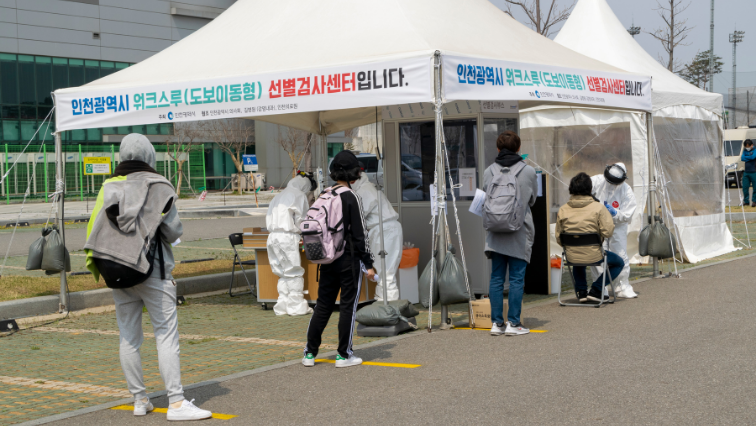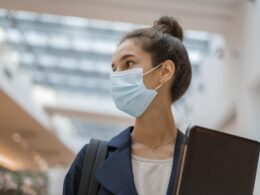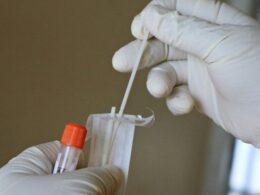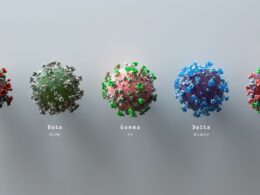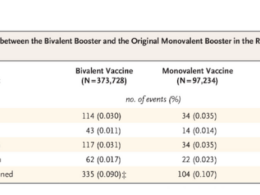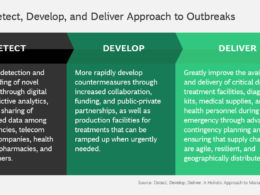South Korea’s Implementation Of A COVID-19 National Testing Strategy
Health Affairs, May 25th, 2021
By Jeffrey Shuren and Timothy Stenzel
Two months after the first case of coronavirus disease 2019 (COVID-19) was confirmed in early 2020, South Korea was commended by many international partners for its efforts to contain the outbreak and avoid regional lockdown.
This is particularly notable considering that it became the second most infected country after China by March 2020.
Much of South Korea’s success in addressing the current pandemic has been attributed to lessons learned from their response to a deadly outbreak of Middle East Respiratory Syndrome (MERS) in 2015, including a national testing strategy.
Following this experience with MERS, the South Korean government implemented changes in two noteworthy areas regarding testing.
- First, several government agencies—including the Korea Centers for Disease Control and Prevention (KCDC), the Korea Society for Laboratory Medicine, the Ministry of Food and Drug Safety (MFDS), and the Korean Association of External Quality Assessment Service—designed rapid responseprocesses for emerging infectious diseases.This included an emergency use authorization (EUA) program to expeditiously authorize certain products for emergency use, which was formally established through the amendment of the Medical Device Act in 2016.The EUA program in South Korea is modeled after the system used in the United States and allows the temporary production, sale, and use of test kits during a pandemic when there is no authorized product available on the domestic market.
- Second, the South Korean government invested in research, development, and commercial test production, as well as information technology infrastructure, to support a sophisticated testing and contact tracing regime.
The US Food and Drug Administration (FDA) has reviewed information, including reports in the press and information made publicly available by the South Korean government regarding their COVID-19 response strategy. The following are key findings regarding South Korea’s approach to setting up a national testing strategy for COVID-19 that may be informative for a future response. (The FDA recognizes that different approaches may work for different countries. We do not make recommendations for what approaches could or should be adopted in the United States for emerging infectious diseases.)
- Investing early in tests
- Mitigating financial risk for test manufacturers
- Streamlining test validation studies
- Developing a coordinated nationwide testing program
- Creating a network of testing sites
INVESTING EARLY IN TESTS
First, South Korea’s Ministry of Science and Information and Communications Technology (MSIT) invested in commercial development of diagnostic tests for infectious diseases prior to the COVID-19 outbreak.
Since 2017, the MSIT has invested almost 27 billion South Korean won (approximately US$25 million) in infectious disease diagnostic technology.
This was an important step in establishing key public and private partnerships that were needed to quickly develop diagnostic tests during the current outbreak.
As a result of these investments and the expectations created through these partnerships, a subset of South Korean commercial manufacturers was well-positioned to develop and manufacture tests quickly.
In fact, two commercial manufacturers began developing COVID-19 tests several weeks prior to the South Korean government’s request to do so.
MITIGATING FINANCIAL RISK FOR TEST MANUFACTURERS
Second, to encourage the development of diagnostic tests by commercial manufacturers, the South Korean government guaranteed both purchasing of minimum quantities of tests and reimbursement once the tests were authorized for emergency use by the MFDS, the FDA’s South Korean counterpart.
This process eliminated the risk that a test developer might lose revenue upon shifting manufacturing lines to tests for SARS-CoV-2, the virus that causes COVID-19.
These types of steps to de-risk and incentivize product development, although later taken for vaccine development, were not taken early on for test development by the US government.
STREAMLINING TEST VALIDATION STUDIES
Third, South Korea’s KCDC (promoted later in 2020 to a standalone agency called the Korea Disease Control and Prevention Agency) established a testing capability in selected laboratories to conduct clinical studies and evaluate commercial manufacturer tests seeking an EUA.
The KCDC submitted the results of these clinical studies with the other studies performed by the manufacturer as part of their EUA request to the MFDS for review.
In contrast, the FDA continued the traditional approach of requiring test developers to conduct their own clinical evaluation of their tests, as no independent testing capability existed in the US at the time.
As a result, test developers in South Korea did not have to find their own clinical specimens or viral material to validate their tests, which likely shortened the length of time needed to complete validation studies to support EUA applications and increased the government’s confidence in test accuracy. (The analytical study and labeling expectations for an EUA are similar in both countries.)
DEVELOPING A COORDINATED NATIONWIDE TESTING PROGRAM
Fourth, South Korea developed a centrally coordinated, nationwide testing program that relied upon a few dozen authorized tests commercially manufactured in high volumes.
To expend its resources efficiently in support of its national testing strategy, South Korea initially accepted EUA requests from only commercial manufacturers for one month (January 28 to February 28, 2020).
The MFDS and the FDA issued their first EUAs for diagnostic tests on the same day, February 4, 2020; the MFDS to Kogene Biotech and the FDA to the US Centers for Disease Control and Prevention.
By the end of February 2020, the MFDS had authorized a total of four EUAs, all for commercial tests that did not use proprietary instruments or platforms, making them accessible to a variety of laboratories.
The FDA had authorized a total of two EUAs and included a third developer, a commercial manufacturer, in one of the EUAs.
In contrast to South Korea, many of the commercial infectious disease test developers in the US use proprietary instruments or platforms, which limits their use to laboratories that have those specific systems.
Many laboratories in the US made their own tests. The FDA accepted EUA requests from all comers, including laboratories, and amassed approximately 2,000 EUA requests for tests by the end of the year.
CREATING A NETWORK OF TESTING SITES
Fifth, South Korea established a network of testing sites and entered testing results into a sophisticated contact tracing system.
Once the first molecular diagnostic tests were authorized for emergency use, the South Korean government collaborated closely with local governments and the private sector to establish testing locations and implement standardized testing procedures.
South Korea also had stockpiled testing supplies, such as swabs.
The first test kits under EUA were distributed on February 7, 2020, to private medical institutions to begin the testing of suspected cases.
The network of eligible locations with onsite COVID-19 diagnostic testing quickly expanded to 100 in April 2020 and 600 in September 2020.
Three types of testing collection stations were designed:
- stations in and around hospitals,
- drive-through stations, and
- walk-through stations.
Laboratories are required to report test results to the government, which can then access personal data on confirmed and suspected cases.
The accessibility of personal data, in connection with test results, has enabled South Korea to effectively contact trace throughout the pandemic.
All suspected and probable cases of COVID-19 are subject to 14-day self-quarantine, and the violation rate has been less than 0.2 percent.
Of course, testing is not an effective tool to contain such an outbreak unless combined with other important measures.
South Korea’s expansive diagnostic testing, contact tracing, and self-quarantine program; social measures including mask wearing, social distancing, and selective and temporary business closures; and an effective communications strategy helped to contain the spread of COVID-19 in South Korea.
Authors’ Note
The authors would like to acknowledge Davina Marano for her assistance with this report.
Health Affairs article
FDA Report
For more details about the approach South Korea took on COVID-19 testing, the FDA has published this report: “South Korea’s Response to COVID-19.”




